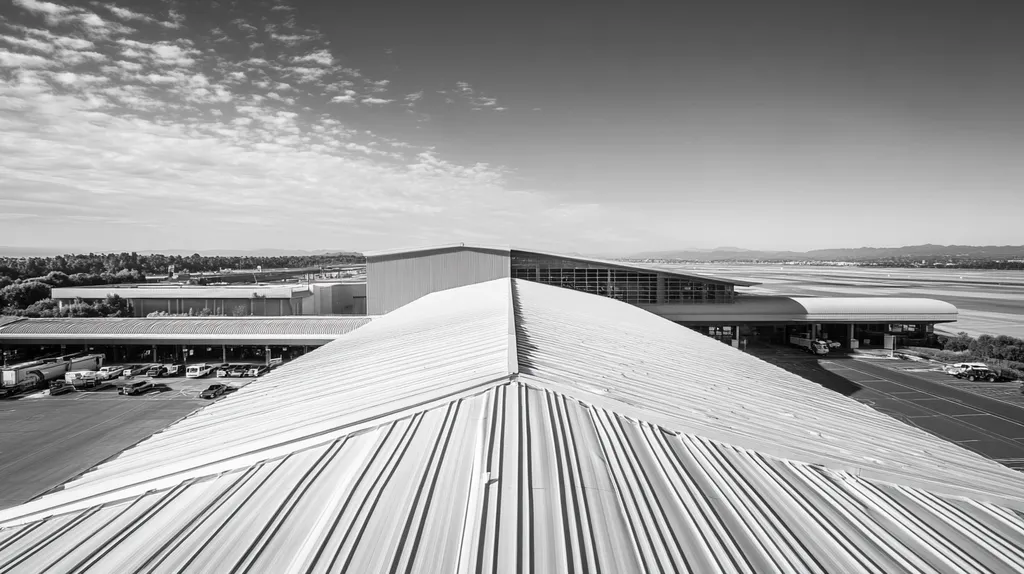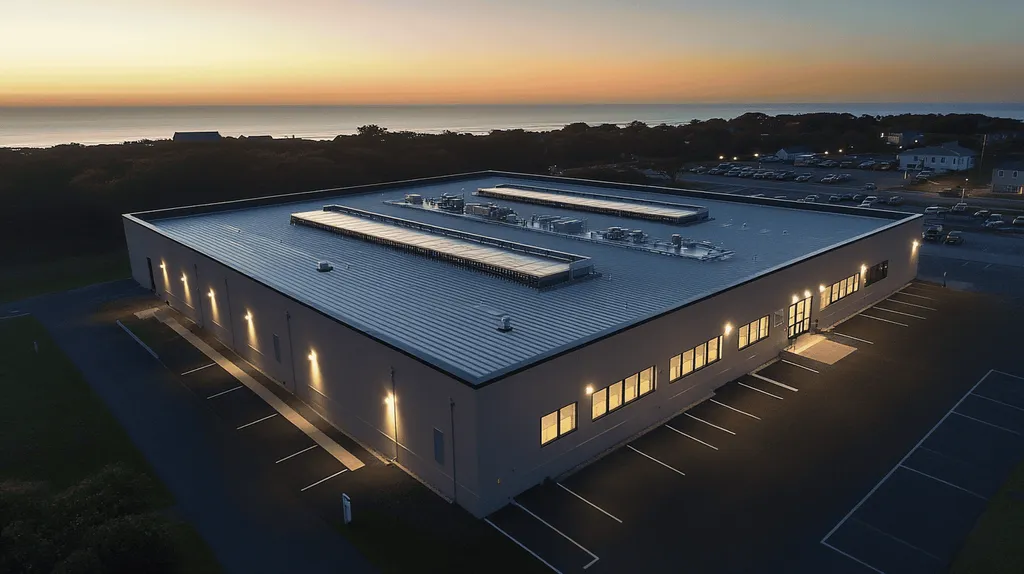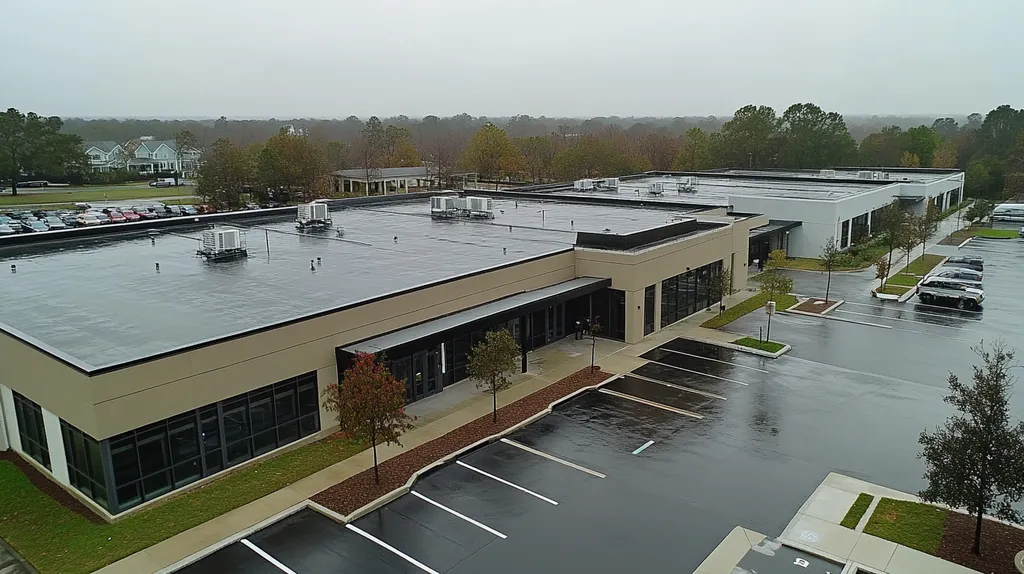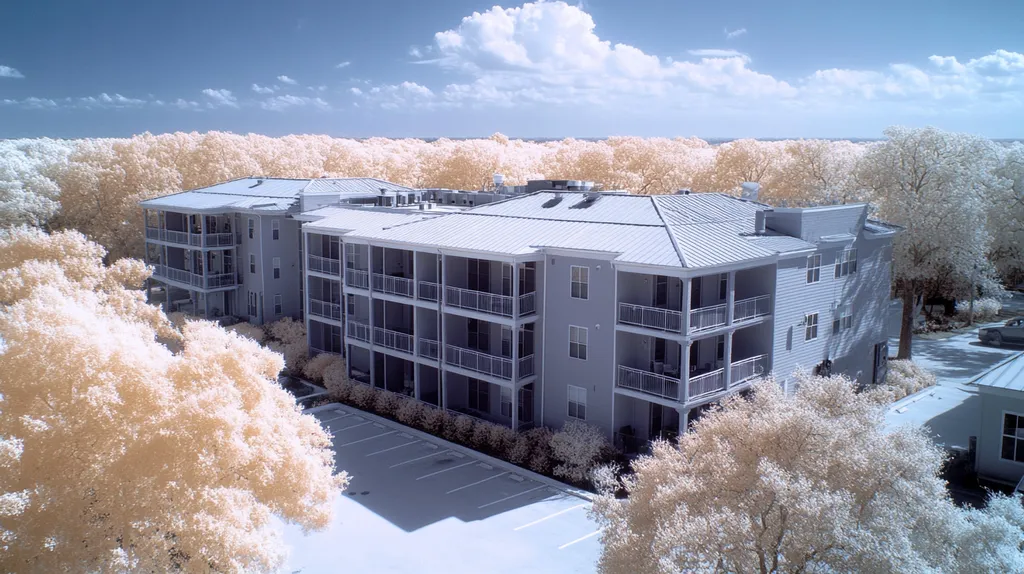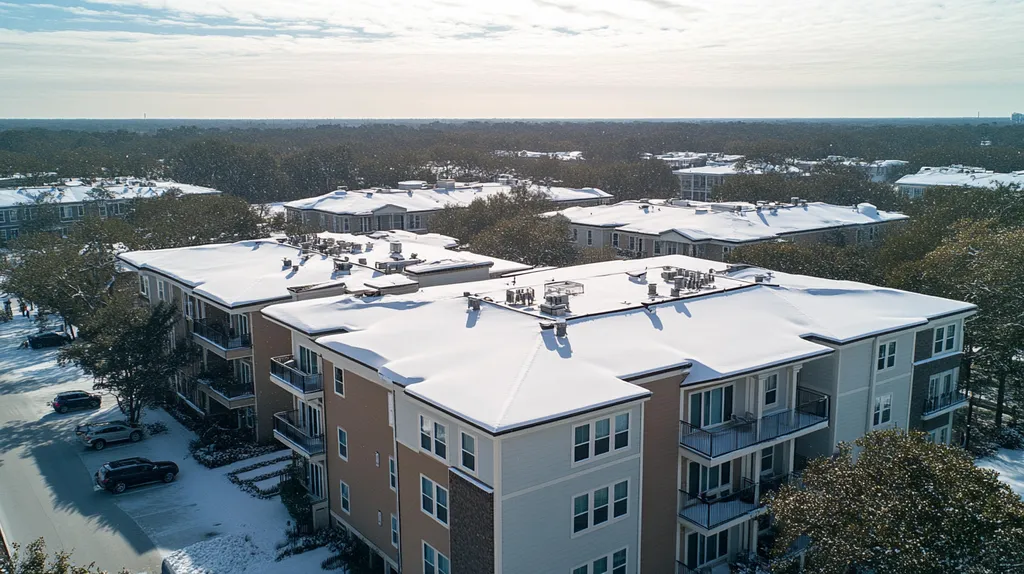When it comes to industrial roofing renovations, the stakes couldn’t be higher. Studies show that poor roofing decisions can lead to damages exceeding $500,000 in a single incident, not counting lost productivity and equipment damage.
From selecting materials that can handle heavy machinery vibrations to navigating complex drainage requirements, industrial roof renovations present unique challenges that demand specialized knowledge and careful planning.
This comprehensive guide explores the critical factors facility managers must consider, from fundamental concepts through optimization strategies, to ensure their industrial roof renovations deliver lasting value and protection.
SECTION 1: FUNDAMENTAL CONCEPTS
Renovating an industrial roof isn’t just an item on the to-do list—it’s a mission critical to safeguarding a facility’s longevity. The financial implications of poor roofing choices can be staggering, with studies indicating that water damage can set building owners back by as much as $120,000 per incident. Grasping the foundational elements of roofing is essential for making savvy decisions that uphold the structural integrity of industrial properties. This includes understanding the types of materials available, the various roofing systems, and environmental factors that can impact performance. Let’s delve into these pivotal topics in detail.
Understanding Roofing Materials
The choice of roofing material serves as the bedrock for a successful renovation. Industrial roofs commonly feature materials such as TPO, PVC, EPDM, and built-up roofing. Each material showcases unique attributes that significantly influence durability, insulation, and resistance to environmental stressors.
TPO and PVC membranes stand out for their energy efficiency and cost-effectiveness. They reflect sunlight, making summer cooling costs easier to manage. On the other hand, EPDM is celebrated for its durability and simple installation, especially suited for flat roofs.
Local climate considerations are vital when selecting roofing materials. For example, in areas experiencing heavy rainfall, a material with excellent waterproofing capabilities is a top priority. Furthermore, the lifespan and warranty of roofing materials can heavily impact investment returns.
Ultimately, aligning material choices with industry standards and the specific needs of the property can mitigate risks associated with potential roof failures.
Roofing System Types
The landscape of industrial roofing systems is diverse, with each type offering distinct advantages and challenges. These systems primarily fall into three categories: single-ply, multi-ply, and built-up roofs. Grasping the differences between these systems is paramount for effective decision-making.
Single-ply systems, like TPO or PVC, are favored for their rapid installation and minimal maintenance, ideal for facilities needing quick turnarounds. In contrast, multi-ply systems, such as modified bitumen, enhance insulation and durability, making them better suited for buildings in harsher environments.
Built-up roofing systems, composed of multiple layers of tar and gravel, provide robust protection against severe weather. However, they demand more extensive maintenance and installation time, which can disrupt normal operations.
Selecting the right roofing system requires careful consideration of immediate budget limitations as well as long-term operational needs and the specific use of the facility.
Environmental Considerations
Environmental factors play a crucial role when renovating an industrial roof. The building’s geographic location, climate, and surrounding environment all influence roofing choices. A thorough assessment is essential to ensuring the selected system can endure seasonal extremes.
For example, roofs in regions with heavy snowfall must be designed to handle the added weight and prevent potential leaks from melting snow. Areas with intense UV exposure need materials that possess enhanced UV resistance to combat rapid deterioration.
Moreover, sustainability is gaining importance, with many facilities exploring ‘green roof’ options or adopting reflective materials that diminish heat absorption. This shift not only aids in regulatory compliance but also contributes to reduced energy expenses.
Lastly, being aware of local environmental regulations is vital for ensuring compliance during renovation efforts, which promotes safety and sustainability while enhancing the building’s overall performance.
SECTION 2: SYSTEM COMPONENTS
Revamping an industrial roof is no small endeavor; it’s a critical initiative that demands a keen focus on its fundamental components. Property owners must appreciate the urgency of this undertaking, as utilizing subpar materials can lead to leaks, expensive repairs, and even structural disasters. Alarmingly, about 30% of commercial roof failures are attributed to inadequate materials and installation methods. This section will explore the essential elements that compose an industrial roofing system: the roof deck and sheathing, waterproofing membranes, and drainage and flashing systems.
Roof Deck and Sheathing
The roof deck and sheathing form the backbone of any industrial roofing system. The deck provides vital structural support while the sheathing acts as a defense against moisture and wind. Common materials used include metal, plywood, and concrete, each bringing its own set of benefits and challenges.
Selecting the appropriate materials is crucial; choosing inferior options can jeopardize the entire roofing system. For example, metal decks are sturdy enough to handle heavy loads but need proper insulation to avoid condensation. On the other hand, plywood sheathing can insulate well but is prone to rot if it comes into contact with moisture.
Conducting regular inspections during renovations can reveal existing deck damage. Property owners should ensure that the deck is strong and stable before adding new layers. Compromised decks may require expensive repairs or replacement, potentially derailing renovation projects.
Investing in high-quality materials for the roof deck and sheathing is essential for durability and longevity. This initial investment can significantly reduce future issues and ensure a solid foundation for any industrial roofing project.
Waterproofing Membranes
Waterproofing membranes are crucial for preventing water from infiltrating the building’s interior. The choice of membrane can heavily affect the roof’s lifespan and maintenance demands. Common options include thermoplastic olefin (TPO), ethylene propylene diene monomer (EPDM), and modified bitumen.
Each type of membrane possesses unique properties that can impact performance. For instance, TPO membranes are recognized for their energy efficiency, while EPDM is lauded for its flexibility, particularly in extreme temperatures. Property owners must choose a membrane tailored to their specific environmental challenges and structural needs.
Using low-quality membranes or poor installation practices can lead to leaks and mold issues, resulting in costly repairs. Engaging experienced contractors who specialize in industrial roofing is vital for ensuring that the installation is executed flawlessly.
Additionally, regular maintenance and inspection of the waterproofing layer can extend its service life. A well-maintained membrane can save property owners from extensive repair costs down the road while preserving the entire roofing system’s integrity.
Drainage and Flashing Systems
Effective drainage and flashing systems are essential for directing water away from the roof and preventing pooling, which can lead to serious structural damage. Without adequate drainage, water accumulation can become a significant liability. Roof drains, gutters, and downspouts must be carefully designed to accommodate local precipitation patterns.
Flashing, made from durable materials like metal or high-quality sealants, should be applied at seams, vents, and other roof penetrations to avert leaks. Improperly installed or damaged flashing can create vulnerabilities that are costly to address.
During renovations, property owners should thoroughly evaluate their existing drainage and flashing systems. Often, these systems may not adequately support new roofing designs or accommodate local weather conditions. Upgrading these components during the renovation can dramatically enhance overall roof performance.
Including proper slope and drainage planning in the renovation is vital. This foresight can mitigate potential water-related challenges and extend the life of the roof, ensuring a wise investment for the property owner.
SECTION 3: IMPLEMENTATION METHODS
Renovating an industrial roof is not just a project; it’s a high-stakes strategy that can significantly impact a facility’s future. Neglecting essential practices during this process can lead to costly repercussions, including a staggering reduction in the lifespan of the roof—up to 50% less! Property owners and facility managers must navigate installation methods, weather constraints, and stringent safety regulations with precision. Knowing the best practices is key to ensuring a successful roof renovation that withstands the test of time.
Best Practices for Installation
Effective installation methods are crucial for extending the life and efficiency of an industrial roof. First and foremost, choosing high-quality materials is essential; cutting corners here can doom the roof to early failure. Partnering with reputable suppliers who offer warranties and certification adds an extra layer of assurance.
Before diving into installation, conducting thorough inspections of the existing structure cannot be overstated. Checking the decking and current materials for damage will help ensure that the new roof adheres properly and prevents future leaks.
Planning is the name of the game! A well-thought-out installation schedule that accounts for specific site challenges will minimize disruption to regular operations. This foresight can keep businesses running smoothly while renovations take place.
Lastly, employing experienced crews who are well-versed in modern roofing techniques enhances installation quality. A skilled workforce familiar with various roofing systems ensures that the installation aligns with industry standards and building codes, safeguarding the investment for years to come.
Handling Extreme Weather Conditions
Extreme weather events are not just annoying; they can derail roofing projects and inflate costs. Heavy rains, snow, or high winds can stall installation and pose safety risks for workers. Therefore, scheduling projects during favorable weather conditions is essential for protecting both personnel and materials.
Using weather-resistant materials can be a game changer. Selecting products engineered to withstand high winds or moisture can enhance the durability of the roof. Additionally, property managers should consider temporary protections, such as tarps, to shield materials during unexpected weather shifts.
Another smart strategy is to implement a contingency plan. Establishing protocols for pausing work and securing the site in the face of adverse weather is critical. With an action plan in place, property owners can mitigate potential damage and reduce costly downtime.
Ultimately, understanding local climate conditions helps managers make choices that align with regional weather patterns. This knowledge leads to resilient roofing solutions and establishes a foundation for long-term stability.
Safety Protocols and Regulations
Safety is non-negotiable in any industrial roofing renovation. Complying with Occupational Safety and Health Administration (OSHA) standards is critical not only for worker protection but also for reducing liability risks for property owners. Therefore, understanding these regulations is vital to safeguarding everyone involved while avoiding potential legal complications.
Implementing comprehensive safety protocols before starting the project enhances the overall safety framework. These protocols should cover fall protection systems, proper equipment usage, and emergency response procedures. Workers must receive thorough training to ensure they are prepared to execute these measures effectively.
Regular safety audits throughout the project solidify compliance and amplify awareness. Incorporating routine checks for equipment and procedures allows teams to spot and address risks before they escalate into significant issues. This proactive stance bolsters the safety culture on-site.
Prioritizing safety enhances overall project efficiency and creates a positive work environment. By embedding safety into every phase of planning and execution, facility managers can dramatically reduce accident rates and protect their bottom line.
SECTION 4: MAINTENANCE REQUIREMENTS
Proper maintenance of an industrial roof isn’t just a wise choice—it’s an urgent necessity that can make or break the health of the entire facility. Ignoring maintenance duties can result in structural damage and eye-watering repair costs, potentially shortening a roof’s lifespan by a staggering 50%. In this section, we will explore essential maintenance practices, including the importance of regular inspections, common problem areas to address, and how to schedule preventive measures effectively. A proactive maintenance plan is your best ally in protecting valuable investments.
Regular Inspection and Monitoring
Regular inspections are the cornerstone of reliable industrial roof maintenance. Conducting these checks at least twice a year helps catch issues before they snowball. For example, tiny cracks or blisters can point to larger underlying problems that, if ignored, may compromise the roof’s integrity.
During these inspections, facility managers should be vigilant about signs of wear, such as pooling water, broken flashing, or loose membranes. Advanced tools like drones or infrared imaging can enhance inspection accuracy and save on labor costs by allowing a thorough look at hard-to-reach areas.
Documenting your findings from each inspection is also crucial. A well-maintained report can highlight trends that may signal emerging issues, making it easier to intervene before minor problems turn into major headaches.
Incorporating weather history into your inspection routines can provide valuable insights into how the roof performs under different conditions, allowing for tailored preventive strategies that align with the facility’s location.
Addressing Common Issues (Leaks, Damage)
Leaks and damage are among the most frequent concerns for industrial roofs. Even a minor leak can wreak havoc, potentially affecting electrical systems or inventory. Promptly addressing these issues is vital to mitigating further consequences.
Facility managers should be trained to identify leak signs, such as water stains or mold growth, and act quickly. Employing qualified roofers for emergency repairs ensures a professional approach to damage control, saving time and preventing costly mishaps.
Often, problems stem from damaged flashing or poorly sealed joints, making it essential to proactively address these potential fail points during regular maintenance. Keeping a repair log will help track recurring issues and create a solid action plan for roofers.
Investing in high-quality materials for repairs, like superior sealants, can bolster the roof’s resilience against environmental challenges, lowering the likelihood of future leaks and extending the overall lifespan of the roofing system.
Preventive Maintenance Scheduling
Preventive maintenance is a powerful strategy that can significantly lower long-term costs and headaches. By scheduling regular maintenance activities, facility managers can ensure roofs are proactively managed rather than just reacting to issues as they arise.
Implementing a preventive maintenance plan often includes routine tasks such as cleaning gutters, removing debris, and checking for thermal expansion problems. These seemingly simple tasks can prevent large-scale issues and contribute to a longer-lasting roofing system.
Using predictive maintenance technologies can also smooth out scheduling and improve accuracy. Sensors capable of providing real-time data on roof conditions can alert facility managers when their attention is needed.
Ultimately, a well-structured maintenance schedule minimizes emergency repairs, safeguarding a facility’s operational efficiency. Investing time and resources in preventive measures not only pays off over time but also reinforces the durability and reliability of industrial roofs.
SECTION 5: PERFORMANCE METRICS
Maximizing a roof’s performance is crucial, especially in the high-pressure environment of industrial settings. A staggering study by the National Roofing Contractors Association reveals that nearly 50% of all roofing issues stem from a lack of maintenance and poor initial assessments. Understanding essential performance metrics is vital for property owners and facility managers aiming to protect their investments and ensure longevity. This section dives into how to effectively assess durability, improve energy efficiency, and perform a cost-benefit analysis of repairs to facilitate better decision-making.
Assessing Durability and Longevity
Durability stands tall as a foundational metric affecting both performance and maintenance costs. Industrial roofs face a barrage of challenges, including heavy machinery emissions, extreme weather, and foot traffic. According to industry estimates, roofs made of high-quality materials can outlast those constructed with inferior options by up to 20 years.
To ensure a roof can withstand the test of time, evaluating its material properties—like UV resistance and weathering capabilities—is essential. Performance tests, such as the ASTM D6083 standard for liquid-applied roofing, provide vital insights into potential failure points.
Additionally, thoughtful roof design can significantly enhance longevity. For example, roofs with proper drainage and insulation systems can minimize thermal shock, a leading cause of premature roof failures.
In conclusion, consistently assessing durability and longevity can guide proactive strategies, ultimately leading to substantial savings throughout the roof’s lifespan.
Energy Efficiency and Sustainability
As utility costs rise and environmental regulations tighten, energy efficiency has become a top priority in industrial roofing. Ineffective insulation can be a hidden drain on resources, with estimates indicating that up to 30% of heating and cooling expenses may be linked to poor roof insulation.
Incorporating sustainable roofing solutions, such as reflective membranes, can dramatically lessen energy consumption and cut cooling bills. Facilities that adopt cool roof technologies could experience surface temperature drops of 10 to 20 degrees Fahrenheit, translating to decreased reliance on HVAC systems.
Moreover, energy-efficient roofs can earn sustainability certifications, like LEED, boosting property value and attracting eco-conscious tenants. Monitoring energy performance metrics not only helps the planet but also brings tangible financial benefits to the organization.
Ultimately, evaluating and optimizing energy use can enable businesses to meet their sustainability goals while enhancing their financial health.
Cost-Benefit Analysis of Repairs
A detailed cost-benefit analysis of roofing repairs can illuminate the best paths forward for facilities. Managers frequently grapple with the decision of whether to repair or replace roofs, and a comprehensive assessment can clarify the situation. While initial repair costs may appear more manageable, failing to factor in long-term efficiency and longevity can lead to escalating expenses.
For instance, ongoing minor repairs on a deteriorating roof can outstrip the cost of a complete replacement over time, especially if recurring leaks cause structural damage. Evaluating metrics such as repair frequency and historical performance data can assist in making informed decisions.
Additionally, the potential downtime during repairs must be considered. Unplanned interruptions can significantly impede operations and lead to revenue losses. By carefully weighing these factors against projected repair costs, managers can devise strategies that minimize disruptions and maximize resources.
In summary, a well-executed cost-benefit analysis empowers property owners to make educated decisions, ensuring wise investments in their roofing systems.
SECTION 5: PERFORMANCE METRICS
The stakes couldn’t be higher when it comes to roof performance in industrial settings. A staggering study by the National Roofing Contractors Association indicates that nearly 50% of roofing issues arise from a lack of proper maintenance and inadequate initial assessments. For property owners and facility managers, grasping essential performance metrics is not just beneficial—it’s essential for protecting investments and ensuring that roofs stay strong. This section highlights the importance of assessing durability, maximizing energy efficiency, and conducting insightful cost-benefit analyses for repairs to support smarter decision-making.
Assessing Durability and Longevity
Durability isn’t just a buzzword; it’s a crucial metric that directly impacts both performance and maintenance costs. Industrial roofs are put to the test by extreme conditions like heavy machinery emissions, harsh weather, and foot traffic. Statistics reveal that roofs constructed with high-quality materials can significantly outlast their inferior counterparts—by as much as 20 years!
To ensure long-term resilience, it’s essential to evaluate the material properties of a roof, including UV resistance, impact durability, and weathering capabilities. Performance tests, such as the ASTM D6083 standard for liquid-applied roofing, provide critical insights into potential weaknesses that could lead to failure.
Additionally, smart roof design—complete with effective drainage and insulation systems—plays a pivotal role in longevity. A carefully designed roof can minimize thermal shock, which is one of the leading causes of premature failure.
In summary, consistently appraising durability and longevity through targeted assessments allows facility managers to implement proactive strategies that can translate to considerable savings throughout a roof’s lifespan.
Energy Efficiency and Sustainability
With rising utility costs and tightening environmental regulations, energy efficiency in industrial roofing has skyrocketed in importance. Poor insulation can have severe financial implications; estimates suggest that a staggering 30% of heating and cooling costs can be traced back to ineffective roof insulation.
Implementing sustainable roofing solutions—like reflective membranes—can substantially reduce energy consumption and lower cooling bills. Facilities that invest in cool roof technologies may see surface temperatures drop by 10 to 20 degrees Fahrenheit, leading to reduced demand on HVAC systems and significant savings.
Moreover, energy-efficient roofs can earn sustainability certifications, such as LEED, which enhances property value and attracts eco-conscious tenants. Tracking energy performance metrics not only contributes positively to the environment but also generates tangible financial benefits for organizations.
Ultimately, evaluating and optimizing energy use empowers businesses to meet their sustainability goals while bolstering their financial health.
Cost-Benefit Analysis of Repairs
An insightful cost-benefit analysis of roofing repairs is invaluable for illuminating the best paths forward. Facility managers often grapple with the decision of whether to repair or replace roofs, and detailed assessments can provide clarity to that dilemma. While initial repair costs might look manageable, overlooking long-term efficiency and longevity could lead to escalating expenses down the line.
Take, for instance, the continuous cycle of minor repairs on a failing roof, which can easily add up to more than a complete roof replacement over time—particularly if regular leaks result in structural damage. Metrics like repair frequency and historical performance data are essential for equipping managers with the insights needed to make informed choices.
Furthermore, it’s crucial to consider the impact of downtime during repairs on operational efficiency. Unplanned interruptions can drive significant revenue losses and productivity declines. By weighing these factors against projected repair costs, property managers can craft strategies that minimize disruptions and optimize resource management.
In conclusion, a well-executed cost-benefit analysis arms property owners with the knowledge necessary to make informed decisions, ensuring that investments in their roofing systems are both wise and strategic.
Looking Ahead
With industrial roof failures costing businesses an average of $250,000 per incident, the stakes for proper renovation couldn’t be higher.
Success demands a comprehensive understanding of unique challenges, from material selection and installation methods to ongoing maintenance requirements.
Property owners who invest in quality materials, follow industry best practices, and implement regular inspection schedules can extend their roof’s lifespan by up to 40%.
By addressing the six critical areas outlined in this guide – from fundamental concepts through optimization strategies – facility managers can safeguard their properties while maximizing return on investment.
The future of industrial roofing lies in proactive management, sustainable solutions, and data-driven decision-making that keeps businesses protected and profitable for decades to come.
FREQUENTLY ASKED QUESTIONS
Q. What fundamental concepts should I know about commercial roofs?
A. Renovating an industrial roof involves understanding roofing materials, systems, and environmental impacts. Each type of material offers unique durability and insulation properties. Understanding these foundational aspects helps you make informed choices, protecting your investment in the long run.
Q. What components are critical in an industrial roofing system?
A. Essential components include the roof deck, waterproofing membranes, and drainage systems. Each plays a crucial role in maintaining structural integrity. Selecting quality materials and ensuring proper installation will prevent leaks and costly repairs down the road.
Q. What best practices should I follow for industrial roof implementation?
A. High-quality materials, thorough inspections, careful planning, and experienced crews are essential. Scheduling installations during favorable weather and adhering to safety regulations ensures smooth operations. All these factors contribute to a successful and durable roofing renovation.
Q. Why is maintenance crucial for commercial roofs?
A. Proper maintenance can extend the lifespan of an industrial roof and prevent costly repairs. Regular inspections help catch issues early, while a proactive maintenance plan safeguards your investment. Neglect can lead to leaks, structural damage, and shortened roof life.
Q. How do I assess the performance of an industrial roof?
A. Assess durability, energy efficiency, and conduct cost-benefit analyses for repairs. Examine material properties and roof design to ensure resilience against environmental factors. Understanding these metrics aids in maintaining a roof’s integrity and optimizing long-term investments.
Q. How can extreme weather affect my industrial roof?
A. Extreme weather can delay installations, damage materials, and pose safety risks. It’s crucial to use weather-resistant materials and schedule work during favorable conditions. Having contingency plans in place ensures effective responses to unpredictable weather events.
Q. What common problems should I watch for on my industrial roof?
A. Common issues include leaks, damaged flashing, and pooling water. Regular inspections can help spot early signs of these problems. Addressing them promptly can prevent costly repairs and ensure the roof remains in good condition.


